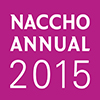By Lindsay Tiffany, Communications Specialist, NACCHO
The following post is part of a series of interviews with local health department (LHD) staff who will present at the NACCHO Annual 2015 conference. Eileen Eisen-Cohen, PhD, MSW, Performance Improvement Manager, Maricopa County (AZ) Department of Public Health, previews her session “Evaluating a Community Health Improvement Plan (CHIP) Partnership by Using PARTNER, a Social Network Analysis Tool—Maricopa County, AZ.” In the session, Eisen-Cohen will co-present with J. Mac McCullough, PhD, MPH, Health Economist, Assistant Professor, Maricopa County Department of Public Health, Arizona State University. Their session will discuss how to effectively evaluate CHIP coalitions.
- Thanks for taking the time to speak with NACCHO Voice about your session at NACCHO Annual 2015. To start, why are CHIPs so important to local health departments (LHDs) and to the health of communities in general?
CHIPs are designed to bring together as many of the partners, in a public health system, to create an action plan to impact the leading public health priority areas identified in the community health assessment (CHA). The CHIP identifies areas where we can have the largest impact on improving the quality of life for all residents, particularly the most vulnerable. This is especially important because within communities there are organizations with similar and different missions that can impact public health when working together. With expertise in evidence-based approaches, population health data, surveillance, evaluation, and community development, LHDs can serve as a neutral convener and backbone support organization for this work.
- What entities or organizations should be included in a CHIP coalition? How do demographics, population size, location, and other factors affect the makeup of a CHIP coalition?
Every organization that can impact any of the health priorities, alone or working with others, should be included in a CHIP coalition. This includes traditional and non-traditional partners in the community. The Health Improvement Partnership of Maricopa County (HIPMC) is a multi-sectoral coalition of more than 75 organizations collectively working to implement the 2012–2017 Maricopa County Community Health Improvement Plan. The HIPMC successfully developed its CHIP by employing a collaborative process to identify the strategies to be included in the plan. More than 80 participants reviewed and selected the evidence-based strategies related to the health priorities, risk factors, and social determinants of health. This set the foundation for a shared vision for the HIPMC and collective ownership of the CHIP.
Partners are directly contributing initiatives from their organizations to the CHIP, demonstrating that it is a shared plan amongst the partnership. By collectively implementing initiatives, the HIPMC is able to make a larger impact on its priorities. For example, to address obesity, one of the HIPMC’s strategies is to “Make the healthy choice the easy choice at worksites.” Numerous HIPMC partners are working to support this strategy with activities such as implementing healthy vending policies and providing technical assistance to employers to make changes related to physical activity and nutrition at their worksites.
- What are some traditional measures used to evaluate CHIP coalitions?
There are numerous frameworks available to help evaluate the effectiveness of coalitions in general. Some of these look at the outcomes of the group while others look at the characteristics of partners that support trust and cooperation. Staff from the Maricopa County Department of Public Health worked with our HIPMC partners to develop a comprehensive evaluation of our work. Firstly, we track progress on our CHIP objectives and action plan. The second piece is about tracking health outcomes of our five health priorities. Both of these quantitative evaluation pieces can be found on our www.maricopahealthmatters.org website. Our most exciting evaluation was looking at the network of organizations through social network analysis.
- How has the PARTNER social network analysis tool helped your LHD evaluate the impact of your CHIP coalition in ways that traditional measures couldn’t capture?
We used the PARTNER social network analysis tool to view how the HIPMC partners work collaboratively and to help identify gaps and opportunities to better achieve our goals. We looked at the resources all the partners bring to the network as well as how closely our individual organizational missions fit the HIPMC vision. This analysis is helping us evaluate how well the collaborative is working in terms of identifying essential partners that are missing from the coalition, looking at resource gaps, and opportunities to improve the work of the collaborative by increasing the number of integrated activities. This measure in particular has been identified as a priority for the group to move us closer toward a collective impact model.
- How has your LHD used the information collected to inform your efforts moving forward?
Next steps in reviewing these data include working with an expert in social network analysis to provide additional analyses and input on the findings and their meaning for MCDPH staff and HIPMC partners. Stakeholders are interested in taking a closer look at what can be learned from these data to improve the strength of the network and have a greater impact on the HIPMC goals. One area to be examined in depth is regarding the resources that organizations bring to the network. The data from this survey reveal many of the resources that are part of the network and those deemed to be most important. The questions to be answered include whether these are the right resources for this effort, to identify needed resources, and to understand the impact that leveraged resources can build upon the capabilities of the coalition, without overtaxing any one organization.
It’s also feasible to develop additional network maps to look at the HIPMC collaborative in different ways. For example, since the work of the HIPMC focuses on the sectors of the community where residents learn, live, work, and seek care, the participating organizations can be coded based on these sectors and the areas desired for impact. It’s also feasible to recode the organizations by sectors of influence (e.g., government, non-profit, community planning, behavioral health, etc.) to identify potential gaps in sectors that should be at the table to improve our outcomes. Does the HIPMC have all the essential partners at the table? If not, which partners are missing and what can be done to recruit them to the council?
 To learn more about the outstanding learning opportunities at NACCHO Annual 2015, July 7–9 in Kansas City, MO, visit www.nacchoannual.org. The early-bird registration deadline is June 4. Register today.
To learn more about the outstanding learning opportunities at NACCHO Annual 2015, July 7–9 in Kansas City, MO, visit www.nacchoannual.org. The early-bird registration deadline is June 4. Register today.









